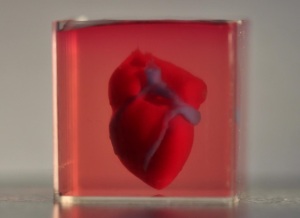by
John R. Fischer, Senior Reporter | April 23, 2019

Israeli researchers have developed
the first 3D heart comprised
of blood vessels and cells
Israeli researchers have developed the first 3D printed, vascularized engineered heart comprising a patient’s own cells and biological materials.
The 3D organ is the first to consist of blood vessels and cells, and is considered a step toward ensuring access to a greater number of heart transplants that carry less risk of being rejected by the body, says the team at Tel Aviv University.
"This is the first time anyone, anywhere has successfully engineered and printed an entire heart, replete with cells, blood vessels, ventricles and chambers," professor Tal Dvir of TAU's School of Molecular Cell Biology and Biotechnology, and leader of the study, said in a statement.



Ad Statistics
Times Displayed: 3029
Times Visited: 33 Fast-moving cardiac structures have a big impact on imaging. Fujifilm’s SCENARIA View premium performance CT brings solutions to address motion in Coronary CTA while delivering unique dose saving and workflow increasing benefits.
The number one cause of death for men and women in the U.S., heart disease often leads to end-stage heart failure, a condition that can only be treated with a transplant. Access to these transplants, however, is limited by a shortage of available donors. There is also the risk of rejection by the body.
The 3D organ is composed of human cells, and patient-specific biological materials that act as bioinks, and are made up of sugars and proteins used for 3D printing of complex tissue models.
Utilizing a biopsy of fatty tissue taken from patients, the researchers separated the cellular and acellular materials and reprogrammed the cells to become pluripotent stem cells. They then processed the extracellular matrix into a personalized hydrogel to serve as the printing "ink", and mixed it with the cells to differentiate cardiac from endothelia cells.
This enabled them to create patient-specific, immune-compatible patches with blood vessels, followed by an entire heart.
The organ in question is the size of a rabbit’s heart but the same technology is necessary for the creation of a human-sized one. The authors plan to transplant their creation in animal models once they have cultured them in the lab and "taught" them to "behave" as hearts.
"We need to develop the printed heart further," said Dvir. "The cells need to form a pumping ability; they can currently contract, but we need them to work together. Our hope is that we will succeed and prove our method's efficacy and usefulness. Maybe, in ten years, there will be organ printers in the finest hospitals around the world, and these procedures will be conducted routinely."
Research was conducted by Dvir; Dr. Assaf Shapira of TAU's Faculty of Life Sciences; and Nadav Moor, a doctoral student in Dvir's lab.
The findings were published in the journal,
Advanced Science.
Back to HCB News

